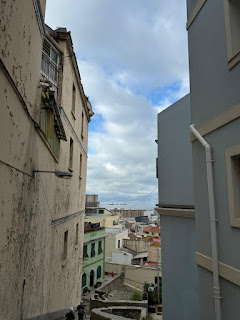We berthed at Catania, nestling in the brooding shadow of Mt Etna. A bus took us to Syracuse and the ironically named Neapolis (ie new city 734 BC)
Taking photos proved addictive, but what they show, doesn’t fully capture sunlight on stone nor the sense of mystery and awe as you wandered through something so old.
As you enter the park the first thing you see is the Latomia del Paradiso (Paradise Quarry). Now it is a peaceful and beautiful garden stroll. Three thousand years ago, it would have been noisy and very far from paradise. Here slaves sweated and toiled, quarrying stone for the new city and its great public buildings.
Dominating the quarry is a narrow cavern, 76 feet high, 214 feet deep and 25 feet wide. Caravaggio called it the ‘Ear of Dionysus’ because of its shape and acoustics. It once housed slaves and another time 7000 prisoners from the war between Athens and Syracuse.
If legend is to be believed, Dionysus, the Tyrant of Syracuse, was able to hear the whispering of mutinous slaves via the cavern’s startling acoustics. We witnessed it ourselves when a bunch of European tourists burst into song: Ode to Joy. A rival bunch of tourists – French – counter-attacked and drowned them out with the Marseillaise
The Greek Theatre
Some believe Greek theatres were aligned to the constellation associated with the gods they were dedicated to. What’s more obvious is the fact they were built in hillsides, using nature as a natural backdrop, not only enhancing the acoustics, but also allowing audiences greater visibility. The position of the sun and prevailing winds were also taken into account. Theatres were often positioned near to the sea, where breezes both cooled the spectators and amplified sound.
Stylised masks amplified sounds through their mouths. The exaggerated features allowed them to be seen from a distance
The Ara di Gerone II
A monolithic sacrificial altar to Heiron II where up to 450 oxen could be killed at one time.
And of course, when the Romans came, so did the Amphitheatre, cannibalised for stone over the years.
Ortigia harbour and sea
Syracuse’s old town centre is connected to Syracuse by two small bridges. It’s a tiny island about a mile long but packed with historical interest and surrounded by a turquoise sea.
Ortigia was the nucleus of Syracuse, founded about 734 BC and eventually becoming the most important city in Magna Graecia. For a time, it dominated the Mediterranean, was home to Archimedes, and was visited by Plato. Later it struggled against Carthage until eventually swallowed up by the Roman Empire where it enjoyed renewed prosperity. In later years, Syracuse, along with the rest of Sicily was influenced by Byzantines, Arabs, and Normans.
Piazza del Duomo
Began life as a Greek temple, developed further by the Byzantines and then Normans and became what we see now in the C18th. It houses palaces and churches and from it a spider-web of narrow, mysterious and beautiful streets
So, what remains of the temple?
The Temple of Apollo
Dominating the square is the Cathedral built in the C7th on the site of a previous Greek temple, and it reflects the complexity of Sicily’s unique culture. On its side wall, you have the ancient Doric columns of the original Greek temple. Above, you can see Norman battlements reflecting their obsession with warfare and defence. And after the great earthquake of 1693, when much of the church was destroyed, it was rebuilt in the Baroque style best seen from the front.
As you walk through the narrow streets, you pass palaces and some glorious buildings.
All this in an island it takes 15 mins to walk around




































